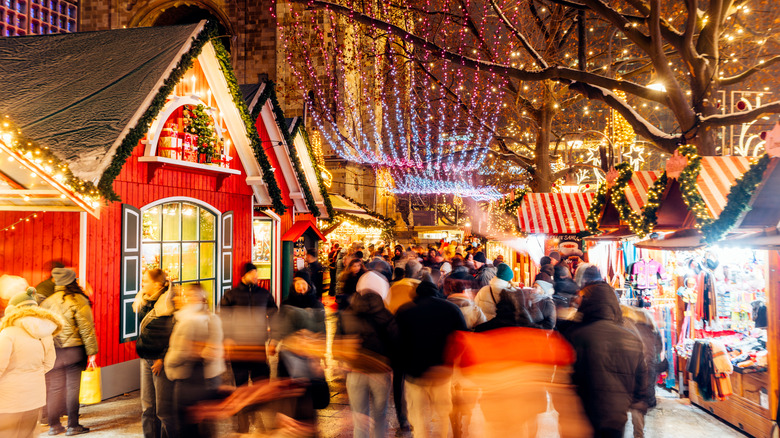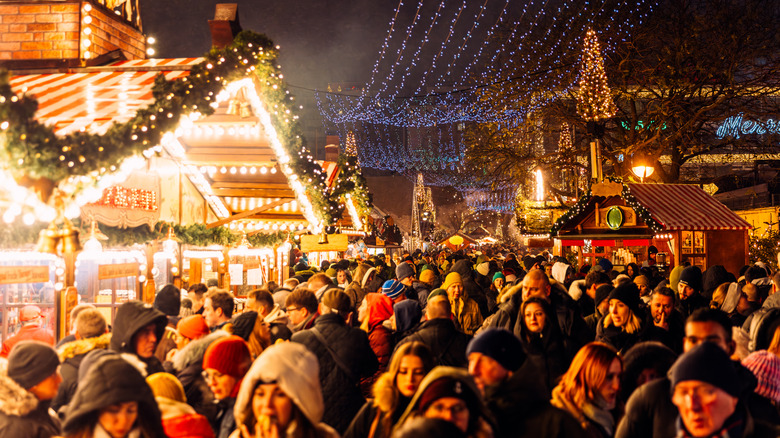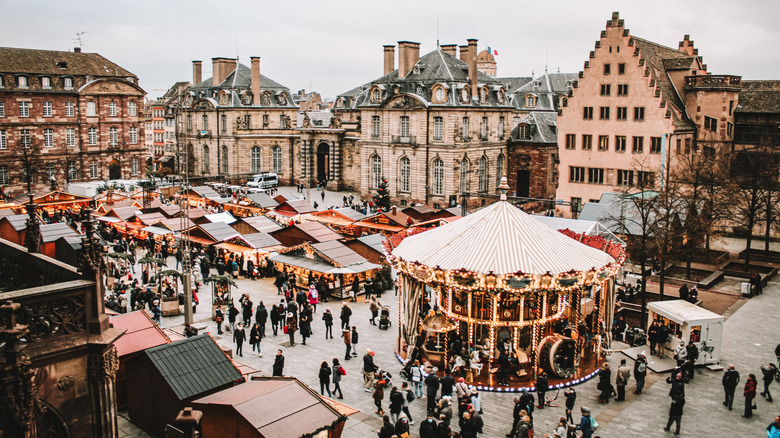10 Crucial Details To Know Before Your First Visit To A European Christmas Market
Come November, across Europe, plans for seasonal Christmas markets are already in full swing. The tradition dates back to 1434 when the first market — known as the Striezelmarkt — received royal consent in Dresden. Others soon followed, and today, there are an estimated 2500 to 3000 markets in Germany alone. Some are better known than others, of course, with Europe's very best Christmas markets being world-famous events, attracting hundreds of thousands of people each year. The variety of craftwork, entertainment, and food varies from country to country and, at times, from market to market. Finding one that ticks all the boxes is an exercise in and of itself.
Still, once you've selected a location, there are a few things you can do to make the most of your time spent there. Squeezing every ounce of enjoyment out of a European Christmas market is as much art as it is forward planning. There are pitfalls to avoid, techniques to employ, and more than a few curveballs to avoid. So, whether you're planning a visit to the markets of Vienna or Krakow, planning a leisurely Christmas cruise down the Danube, or simply looking for some advice on how to navigate unfamiliar territory, here are some of the most important things you need to know about your foray into a festive winter wonderland.
Do your research
With so many markets operating across the continent any attempt to find a set of uniform rules is doomed to failure. Some markets open in November and stay open until the first week of January. Others open much later and are already closed by the time Christmas Eve rolls around.
Assuming any given venue is open simply because it feels like Christmas is probably not the best strategy. Most markets have their own websites, so checking dates and opening times can help you avoid disappointment. Such resources can also inform you as to what to expect and when to expect it. The larger markets usually put on shows and events such as the Krampus parades of Salzburg or the concerts, carol singers, and storytellers of Strasbourg, home to one of Europe's oldest Christmas markets. These happen at specific times or dates, so you might want to plan around them.
Local knowledge is another invaluable tool. A hotel's concierge can recommend the best times to attend the market, steering you towards those off-peak moments that promise a crowd-light experience. They might also know a few other tips, such as where to get the best mulled wine, how many cinnamon pretzels one can safely consume in a 24-hour period, or whether käsespätzel is as tasty as it sounds. And, of course, they are probably sitting on some secret knowledge about the more out-of-the-way gems that the tourist scrum passes by altogether.
The language barrier
The EU alone has 24 official languages so there's a good chance that on any given excursion, you're going to face a linguistic challenge or two. Although Christmas markets are keen to attract tourists, but many of them — especially the smaller ones — cater just as heavily to locals. Signage abounds, but English translations alongside the native language offerings are not a given. In some cases, this is by design; direct translations for food items such as käsespätzel simply do not exist. And while, in many cases, it might be obvious from sight as to what the item is, there are times when knowing your rybí polévka from your bredele really comes in handy.
You'll find that most vendors speak at least some English, but as patchy language skills collide with the hustle of a busy market, confusion sometimes abounds. For people with dietary restrictions, this sometimes takes on an ominous tone. Familiarizing yourself with a few key phrases can make all the difference, as can a little research into which local delicacy is a must-try and which ones are best avoided. Failing that, there is always technology; phones can translate signs or conversations in real time, but again, peak traffic moments sometimes get in the way of this. The option to Google an unfamiliar word exists, but such searches only provide a broad overview; the aforementioned rybí polevka, for example, is a Czech delicacy made from a carp's head and roe. Google's one-glance translation refers to this not-for-the-faint-hearted dish simply as a fish soup.
Beware of cheap trinkets
The quintessential European Christmas market is comprised of three elements: Food, entertainment, and crafts. As a rule of thumb, the food is universally fantastic, and the entertainment is free, but the collectibles, decorations, and trinkets on sale vary in terms of quality and specialization. Dresden's Striezelmarkt, for example, focuses on the lace and porcelain that the city itself has long been famous for. Budapest, a city well known for its romantic river cruises on the Danube, is famed for exquisite leatherwork. Meanwhile, the Viennese obsession with snow globes, or Schneekugel as they are known locally, finds expression in any one of the 20 official Advent markets you'll find sprinkled across the city.
In most cases, the quality bar is relatively high, but it pays to be cautious. As a rule of thumb, the more touristy the location the greater the chance that you'll wind up picking up an inferior item. Markets are comprised of a series of temporary stalls or chalets, and returning something that did not meet expectations is, at times, fraught with difficulty.
Even so, the odd cheaply made souvenirs here and there never hurt anyone, and those looking to add to their collection of Christmas market mugs, cute snow globes, or bespoke ornaments can do so with peace of mind. More expensive purchases, however, are best left for more permanent shops or genuine artisans working at the market.
Wrap up well
Christmas markets, of course, take place during the heart of winter. A stroll around a Seville market is one thing, but the further north and east you travel, the colder things are going to get. In such parts of Europe, temperatures drop to the low 30s on most evenings, and in many places, it can get considerably colder than that.
The usual advice pertains. Layers are essential, as are hats, gloves, and scarves if you're planning on visiting a market in the far north. Indeed, the need for such items is pressing enough that there's usually a stall or two dedicated to winter clothing; tourists who've miscalculated just how cold it gets are generally eager to buy. Failing that, a mug of hot chocolate or mulled wine can help stave off the shivers.
Those sensitive to the cold might want to consider avoiding the most extreme climates in Europe. A visit to Copenhagen, when all you need to deal with is a quick dash from the hotel lobby to a cab, is easily endured. But Christmas markets are primarily outdoor affairs where people congregate in the cold for hours at a time. Of course, as with everything in life, there is also a trade-off at play here. The further south you go, the less likely you are to encounter that Instagram-worthy winter wonderland experience.
Visit during off-peak times
Christmas markets in Europe are almost always free to enter and take place in some of the most prominent areas of the city. Commuters on their way to or from work often stop by to do a little shopping, grab something to eat, or else hang out with friends and family. The closer you get to Christmas day, the more hectic things become. In some ways, the crowds are all part of the experience but, in truth, there are times when spending 30 minutes queuing up for a cup of mulled wine in the cold begins to feel like something of a chore.
Fortunately, off-peak times are a thing, and avoiding mealtimes is a good place to start. Breakfast, lunch, and dinner can be protracted, as locals appear in droves to get their fix of seasonal treats, and these hours often see the longest lines form. Evenings can also get quite busy, although things tend to peter out towards the wee hours of the night. Weekends, however, are universally well-trodden, so if you wish to avoid the scrum, weekdays — with the exception of Friday nights — are your best option.
Timing is also critical. The first few days of the market tend to be busier, as people gravitate towards the novelty of the newly opened stalls. Finding a sweet spot for your visit is tricky, but aiming for something equidistant between the start of Advent and the end generally works.
Return your mugs
Christmas markets tend to be classy affairs, and while it's true that there are places where you can get a beverage in a paper cup, the more traditional markets make a point of serving them in high-quality, festive-themed mugs. These mugs are yours to keep, but there is a catch. Markets can be chaotic places, and the owners of chalets can't always run around collecting non-disposable items. Linguistic challenges might obfuscate the fact that the price of the mug is often included in the cost of the drink. That means you're paying an inflated price for your cup of spiced wine.
For those who lack the desire — or luggage space — for a collection of seasonal earthenware, there is always the option to return it and get some money back for doing so. The same is true for refills; it's generally better to hand the mug back so you don't wind up with a collection of them at the end of the night and a long wait to get your deposit. Still, some people love to collect Christmas market cups, so if you do forget to return yours, there are often buyers on the internet, interested in collecting a complete set, for those who take the time to seek them out.
Choose your market carefully
Selecting a market is not just about the destination in question; even within a single city, not all markets are equal. Some, for example, specialize in specific crafts or foods, while others are better known for their rides or events. Meanwhile, certain markets rise above others in terms of scale and popularity. Knowing what you want from the market, and what any given city offers outside of that, is half the battle.
The more central the market, the busier it tends to get. The risk of encountering overpriced tat also feels at least somewhat linked to the size and scale of these inner markets. Don't expect this to change much if you opt for a more out-of-the-way experience, such as a winter visit to crowd-free Crete for the Heraklion Christmas market. Those looking for a more intimate spot would do well to look to the outlying areas of cities, where smaller markets tend to proliferate. Most medium-sized cities in Germany and Austria have markets of their own, and this is also true — to a lesser extent — of many other European destinations, Crete included.
Of course, such low-key locations often lack some of the dazzle of the capital city offerings. You might find an absence of crowd-pleasing events such as outdoor ice rinks, exciting rides, and festive displays. Whether such a trade-off is worth it or not depends very much on individual tastes.
Book early
Most Christmas markets are free to enter so there's no need to book for them, but the same can't be said for accommodation. The more popular markets tend to take place on plazas, and consequently, nearby hotels are often fully booked up by the time people's minds turn to Christmas. It's worth noting that even those who wrap up well are likely to struggle with inclement weather, so being close to the action is a definite boon.
There's no Thanksgiving celebration in Europe, so post-Halloween, the commercial push toward the Holiday season begins in earnest. Indeed, from November 1st travel agents begin pushing Christmas market city breaks and river cruises in earnest, offering patrons discount flights and accommodations. With such marketing pushes comes an inevitable glut of demand, and for those set on specific dates or locations, this can lead to a compromise or two when it comes to your trip. However, it's worth remembering that these deals lack any real substance. The markets are well-known, as are city breaks or most other December travel destinations. With a little research, there's nothing stopping you from selecting a market and booking accommodation months before the marketing campaign stimulates a stampede.
Pace yourself
It's a simple truth that there are so many things to see, do, and eat at a Christmas market that a trolley dash approach might not be the best option. Those who have gone to the effort of booking a European Christmas break might want to pause every now and then to savor the experience.
The desire to try everything as soon as you arrive is understandable. The fairs are usually alive with enticing aromas, and the festive spirit is contagious. Still, this isn't a single Christmas meal where eating to excess is near-mandatory. The market isn't going anywhere, so opting for a few leisurely visits over the course of your vacation is definitely a better option.
It's also true that the markets take on vastly different characteristics depending on the time of day. A daytime visit feels like a shopping experience. At night, revelry begins, and the sights and sounds blend into a tapestry of events, scents, and merrymaking.
Don't be afraid to try new things
The atmosphere at European Christmas markets is contagious by design. Everything is themed, from the fake snow on the chalets (in those places that need fake snow) to the lights, the smells, and the background music. At first glance, it all looks familiar enough, but upon closer inspection, you might find some rather startling idiosyncrasies. Indeed, within commonly understood Christmas norms, there are a wealth of traditions specific to certain regions. In Germany, Santa fills children's shoes with sweets if they've been good, and twigs if they haven't. Meanwhile, Polish people enjoy a traditional meal known as Wigilia on Christmas Eve; in Spain, children beat up an anthropomorphized log until it poops out treats, and; in Sweden, it's customary to leave out a bowl of porridge in order to assuage the house gnome's wrath.
Most European countries take immense pride in these traditions, and they inevitably find expression in their respective markets. Fairs in Krakow serve traditional Wigilia food, logs full of sweets are on sale in Catalonia, and Stockholm has a forest of gnome merchandise on offer. And then there's the gobbling down of local cuisine. Sweets are vibrant with familiar Christmas spices, but the savory offerings often veer away from the North American norm. Christmas food leans towards the unpretentious with an emphasis on simplicity that's hard to disavow.
Even the most unfamiliar of dishes packs a lot of flavor with very few surprises in store for those feeling trepidatious. Although many of the items — a bowl of goulash, plate of German kartoffelpuffer, or mug of Danish glögg — might seem unfamiliar, they're sold at the market for one reason and one reason alone. They are delicious.
Methodology
I've been fortunate enough to have visited dozens of European Christmas markets over the years, and I've picked up a few tricks along the way. Of course, finding the less crowded spots is only an issue for those who don't like crowds, and booking early takes away some of the spontaneity of a market vacation, so the adage, you do you, is certainly one to abide by. The important thing is to have fun and remember that each sprawling market has something special to offer a prospective visitor. Christmas is, after all, no time to overthink things.











